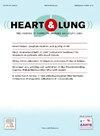Reliability, internal consistency, and validity of the World Health Organization disability assessment schedule (WHODAS) 2.0 among adults with heart failure
IF 2.4
4区 医学
Q2 CARDIAC & CARDIOVASCULAR SYSTEMS
引用次数: 0
Abstract
Background
Heart failure (HF) imposes significant disability. The World Health Organization Disability Assessment Schedule (WHODAS) 2.0 is a generic instrument that measures disability. Although it has been used in HF, no previous study has investigated its measurement properties in this group.
Objective
To assess the test-retest reliability, internal consistency, convergent, and discriminant validity of WHODAS 2.0 in individuals with HF.
Methods
We conducted a cross-sectional study that included individuals with HF treated at the outpatient cardiology center. Data included sociodemographic and clinical (e.g., New York Heart Association - NYHA) characteristics, estimated functional capacity (Duke Activity Status Index - DASI), quality of life (Minnesota Living with Heart Failure Questionnaire - MLHFQ), and disability (the WHODAS 2.0 36-item version). We assessed associations, using Pearson's correlation coefficient or the Kruskal-Wallis test, between the WHODAS 2.0 scores and the MLHFQ, DASI, and NYHA. The WHODAS 2.0 results were collected again seven days after the initial assessment for reliability (intraclass correlation coefficient - ICC).
Results
Participants were 100 people with HF (M age = 57.8 ± 14 years, 57 % men), of whom 84 % were literate. The WHODAS 2.0 was reliable (ICC = 0.789) and had good internal consistency (Cronbach's alpha >0.7 in all domains). Convergent validity was observed through moderate correlations with DASI and MLHFQ and discriminant validity with statistically different results according to NYHA classes.
Conclusion
WHODAS 2.0 is a reliable, consistent, and valid instrument for measuring disability in individuals with HF. Further research is needed to evaluate other properties, such as its responsiveness to interventions.
世界卫生组织残疾评估表(WHODAS)2.0 在成人心力衰竭患者中的可靠性、内部一致性和有效性。
背景:心力衰竭(HF)会导致严重残疾。世界卫生组织残疾评估表(WHODAS)2.0 是一种测量残疾程度的通用工具。虽然它已被用于心力衰竭,但此前还没有研究调查过它在这一群体中的测量特性:目的:评估 WHODAS 2.0 在高频患者中的重测可靠性、内部一致性、收敛性和判别有效性:我们进行了一项横断面研究,研究对象包括在心脏病学中心门诊接受治疗的高血压患者。数据包括社会人口学和临床(如纽约心脏协会--NYHA)特征、估计功能能力(杜克活动状态指数--DASI)、生活质量(明尼苏达心力衰竭生活问卷--MLHFQ)和残疾(WHODAS 2.0 36项目版)。我们使用皮尔逊相关系数或 Kruskal-Wallis 检验法评估了 WHODAS 2.0 评分与 MLHFQ、DASI 和 NYHA 之间的关联。在首次评估七天后再次收集WHODAS 2.0结果,以确定其可靠性(类内相关系数-ICC):参与者为 100 名心房颤动患者(平均年龄为 57.8 ± 14 岁,57% 为男性),其中 84%识字。WHODAS 2.0具有可靠性(ICC = 0.789)和良好的内部一致性(所有领域的Cronbach's alpha均大于0.7)。通过与 DASI 和 MLHFQ 的适度相关性观察到了收敛有效性,根据 NYHA 分级观察到的不同结果在统计学上也存在差异:WHODAS2.0是一种可靠、一致且有效的测量HF患者残疾程度的工具。结论:WHODAS 2.0 是测量心房颤动患者残疾程度的可靠、一致且有效的工具,但还需要进一步的研究来评估它的其他特性,如对干预措施的反应性。
本文章由计算机程序翻译,如有差异,请以英文原文为准。
求助全文
约1分钟内获得全文
求助全文
来源期刊

Heart & Lung
医学-呼吸系统
CiteScore
4.60
自引率
3.60%
发文量
184
审稿时长
35 days
期刊介绍:
Heart & Lung: The Journal of Cardiopulmonary and Acute Care, the official publication of The American Association of Heart Failure Nurses, presents original, peer-reviewed articles on techniques, advances, investigations, and observations related to the care of patients with acute and critical illness and patients with chronic cardiac or pulmonary disorders.
The Journal''s acute care articles focus on the care of hospitalized patients, including those in the critical and acute care settings. Because most patients who are hospitalized in acute and critical care settings have chronic conditions, we are also interested in the chronically critically ill, the care of patients with chronic cardiopulmonary disorders, their rehabilitation, and disease prevention. The Journal''s heart failure articles focus on all aspects of the care of patients with this condition. Manuscripts that are relevant to populations across the human lifespan are welcome.
 求助内容:
求助内容: 应助结果提醒方式:
应助结果提醒方式:


